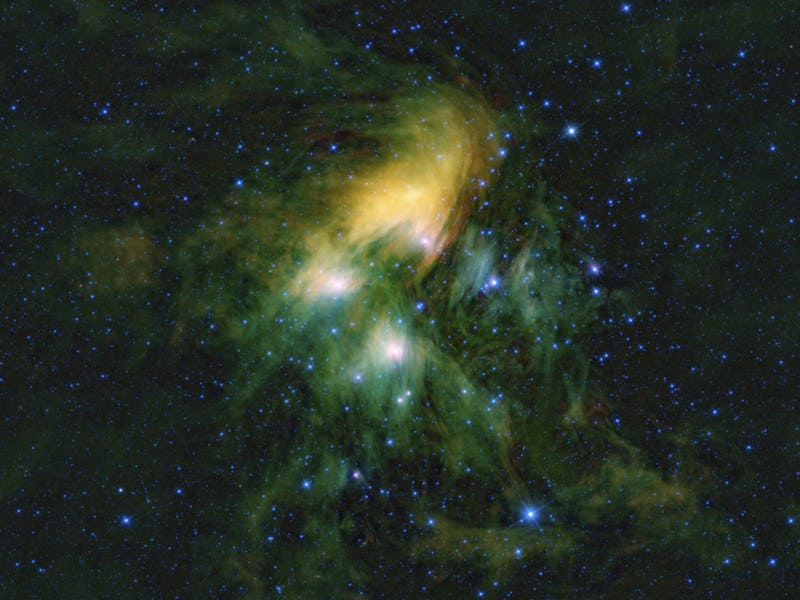How to watch Venus and Pleiades meet in a rare cosmic rendezvous this weekend
Every eight years, this bright planet and star cluster appear to hug one another in the night sky.

On Friday, April 3 2020, the night skies will put on quite a show as two dazzling cosmic objects come together for a rare snuggle.
And if you are in the northern hemisphere, you may have the privilege of watching this rendezvous go down in real-time, and without any specialist equipment.
In this rare meeting, Venus, the brightest planet in the Solar System, and the second brightest object in the night sky after the Moon, will essentially be embraced by the Pleiades, a constellation also known as the "Seven Sisters."
The Pleiades is one of the closest star clusters to Earth, making it visible and bright to the naked eye.
Over the course of Friday and Saturday this weekend, Venus will graze past the Seven Sisters, almost appearing to kiss the constellation just south of Alcyone, the brightest star in the cluster, as Sky and Telescope reports.
Here is how you can view the meeting, and what makes 2020's April skies just so special.
- How to see Venus meet the Pleiades:
If you are in the northern hemisphere and look up at the night skies on April 3, you can see this amazing cosmic come-together just with the naked eye. Grab a pair of binoculars for a closer look.
The rare sight is also a great opportunity for a group photo in the night sky.
To make sure you are looking at the right thing, first look for Venus. The planet appears as the brightest star in the western sky, and is visible during evening twilight.
As the sky gets darker, the glistening seven stars that make up the Pleiades cluster will start to shimmer in, appearing near Venus' bright spark.
Should the skies not be clear enough to get a good view on Friday, both the night of Thursday, April 2 and Saturday, April 4 also make for a good skywatching opportunity, as the planet will still be extremely close to the star cluster.
In fact, Venus will remain within 5 degrees of the cluster through April 9, according to Sky & Telescope.
For those who are not in the northern hemisphere or who miss this backyard astronomical opportunity, the next best option would be to view the main event via livestream through The Virtual Telescope here. They will start streaming at 1:30 p.m. Eastern on April 3.
- Why is April 2020 special?
Technically, Venus meets with the star cluster every year. But rarely does this meeting end in such a tight embrace.
This year’s kind of close encounter only occurs once every eight years. The last one took place on April 3, 2012.
In 2021, for example, Venus will pass by Alcyone at a distance of about 4 degrees to the south of the star, on May 9, 2021. To our eyes, this won't appear so remarkable, nor so close.
The Pleiads star cluster only appear in our night sky for six months a year.
The reason why this tight embrace doesn’t happen every time the two celestial objects meet is because Venus and Earth are in what is known as an orbital near resonance.
That means that 13 orbits of Venus around the Sun equals eight Earth orbits, according to EarthSky. As a result, Venus appears in the same spot in the sky as seen from Earth every eight years.
But Venus’ orbit is a little tilted in relation to Earth’s orbit, so the long-awaited eight year encounter is slightly different each time.
The weekend's viewing will also be a last chance to observe the Pleiades cluster in all its stellar glory. The Seven Sisters only greet our skies for six months of a year.
Stay tuned for more — After witnessing this bright encounter in the sky, your backyard astronomy adventures have only just begun.
Next week, on Tuesday, April 7 2020, look up for a view of a full, Pink Moon in the night sky. This first full Moon of the spring happens to be a Supermoon.
Unfortunately, the name Pink Moon does not reflect its color. Instead, it refers to the blossoming of flowers during this time of year, according to the Farmer's Almanac.
The full Moon will reach peak brightness at 10:35 p.m. Eastern time on Tuesday evening.
For more tips on how to get started on skywatching from home, Inverse has put together a list with the help of astronomers.